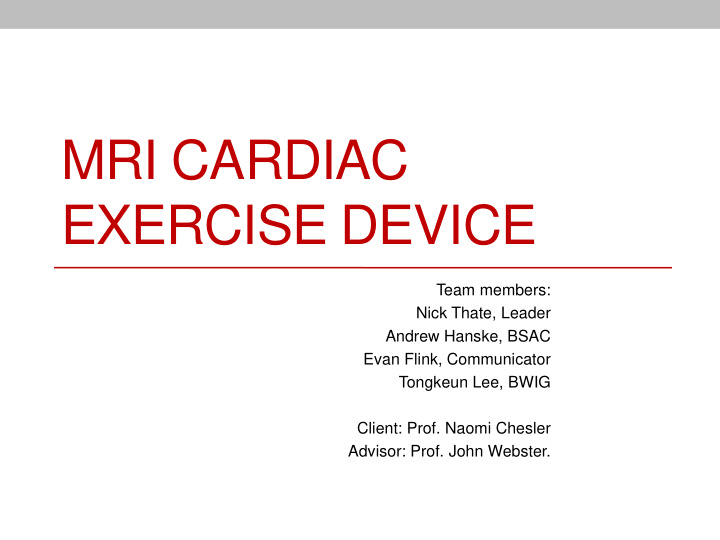



MRI CARDIAC EXERCISE DEVICE Team members: Nick Thate, Leader Andrew Hanske, BSAC Evan Flink, Communicator Tongkeun Lee, BWIG Client: Prof. Naomi Chesler Advisor: Prof. John Webster.
Outline • Problem Statement • Background Information • Competition and Past BME Designs • Preliminary Testing Results • Design Options • Leg Extension • Leg Press • Stepper • Design Matrix • Final Design • Future Work • Acknowledgements / References
Problem Statement • Design an exercise device to be used in cardiac MRI scans in order to diagnose and assess pulmonary hypertension • Client requirements • MRI compatible materials • Exercise within the bore • Comfortable supine exercise motion • Sufficient resistance to increase cardiac output • Adjustable workloads • Reasonable size and weight • Minimal upper-body movement
Background Information • Pulmonary Hypertension • Abnormally high blood pressure in pulmonary arteries • Decreased artery diameter • Enlarged right ventricle • Chronic decreased blood [O 2 ] • Symptoms • Chest pain or pressure • Fast heart rate, shortness of breath • Fatigue/weakness, light-headedness • Swelling of lower extremities http://health.allrefer.com/health/primary- pulmonary-hypertension-primary-pulmonary- • Traditionally assessed with hypertension.html invasive procedure
Competition • Lode B.V. MRI Ergometer • Expensive ( > $28,000) http://www.lode.nl/en/product s/mri_ergometer • Cycling motion • MRI-compatible Treadmill • Developed at Ohio State University • Exercise occurs outside of the MRI tube • Less accurate results http://www.medcitynews.com/2009/05/commercializati on-ramps-up-on-ohio-state-university-treadmill-used- for-mri-heart-tests/
Past BME Designs • MRI Lower Leg Exerciser • MRI Leg Exercise Device • Spring 2010 • Fall 2010 • Excess friction • Unnatural loading • Insufficient workload • Bulky
Preliminary Testing • Constructed mock MRI bore • Tested exercise options • Excluded biking • Desired Heart Rate: >70-80% of Max HR • Exercise data: Leg Extension Leg Press Stepper Calf Machine Time (min:sec) 3:30 3:00 3:00 1:20 Work Load 90 lb (41 kg) 170 lb (77 kg) 68 rpm 160 lb (73 kg) Heart Rate (bpm) 158 134 164 123
Leg Extension Motion
Leg Extension Design • Pros • Natural motion • Light-weight & relatively small • Effective at raising heart rate • Cons • Some muscle fatigue • Durability concerns
Leg Press Motion
Leg Press Design • Pros • Effective at raising heart rate • Most durable design • Cons • Largest design • Unnatural aerobic motion • Some muscle fatigue • Most upper-body movement
Stepper Motion
Stepper Design • Pros • Natural, comfortable motion • Most effective at raising heart rate • Reduced friction • Cons • More moving parts • May not disassemble easily
Design Matrix Weight Criteria Leg Extension Leg Press Stepper 0.2 Patient Comfort 6 7 9 0.2 Motion Mechanics 9 7 8 0.2 Effectiveness 8 7 9 0.15 Durability 6 8 7 0.1 Ease of Assembly 8 7 6 0.1 Size/Weight 9 6 8 0.05 Cost 9 7 7 Weighted Average 7.65 7.05 8
Final Design • Primary materials: • HDPE, Delrin • Brass fasteners • Glass bearings • Elastic resistance: • Light-weight, resistance can vary, subject to fatigue • Weight resistance: • Heavy/bulky, consistent, durable
Future Work • Order materials and components • Construct and assemble prototype components • Test effectiveness of prototype • Test compatibility of prototype with MRI • Successfully acquire pulmonary blood pressure data through MRI scans before, during, and after exercise
Acknowledgements • Prof. Naomi Chesler • Prof. John Webster • Prof. Darryl Thelen • Alejandro Roldan • Previous BME Design Teams References • Blaivas, A.J. (2010, April 27). Pulmonary hypertension . Retrieved from http://www.ncbi.nlm.nih.gov/pubmedhealth/PMH0001171/ • Lode B.V. (2008). MRI Ergometer . Retrieved from http://www.lode.nl/en/products/mri_ergometer • McGuire, J., et. al. (2010, December 10). MRI exercise device. Retrieved from http://bmedesign.engr.wisc.edu/websites/project.php?id=332 • Murray, A. (2009, May 14). Ohio state team creates new company based on university invention . Retrieved from http://www.osu.edu/news/newsitem2425 • Yagow, D., et. al. (2010, May 6). An MRI-compatible lower-leg exercising device for assessing pulmonary arterial pressure. Retrieved from http://bmedesign.engr.wisc.edu/websites/project.php?id=29
Recommend
More recommend